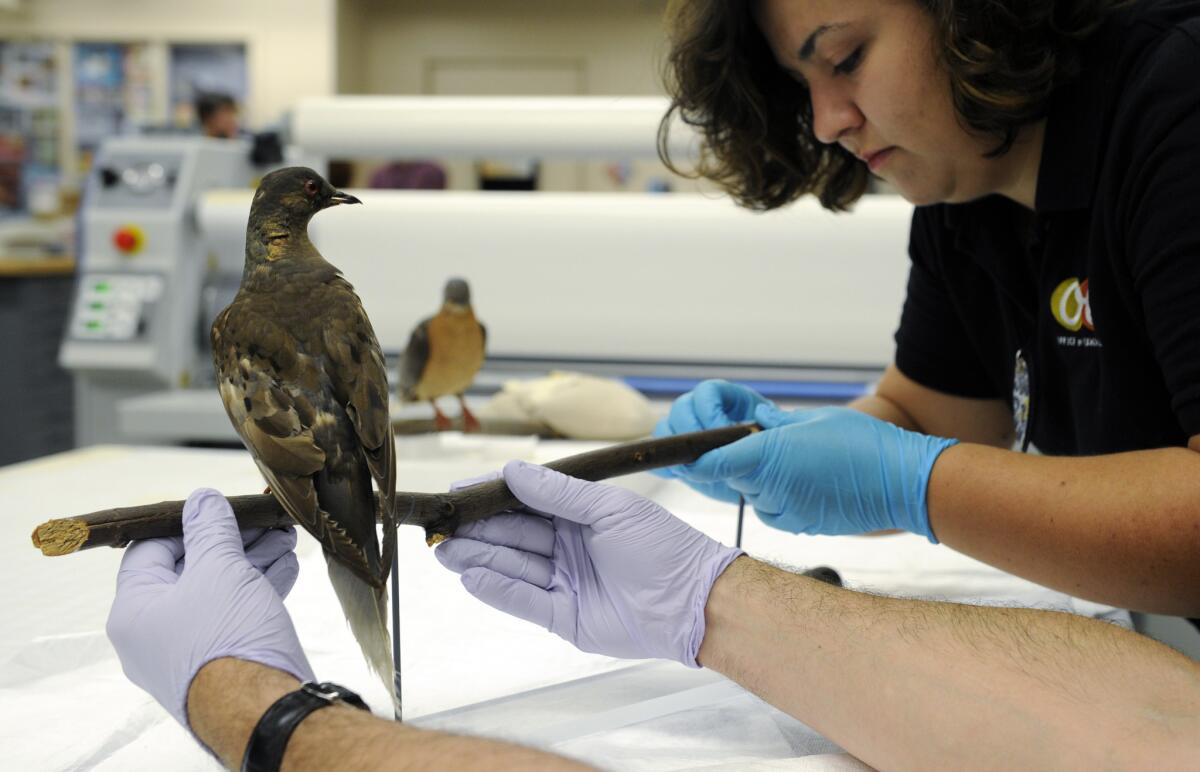Op-Ed: Tumamoc Hill, birthplace of restoration ecology

- Share via
Early in the morning, walkers huff up a steep road on Tumamoc Hill in Tucson, passing tall saguaro cacti. In season, beside white saguaro flowers, white-winged doves hoot like owls. Among rocks, javelinas root for food, bobcats hunt. Tumamoc has long been a gathering place. The first human culture there was the Cienega, dating to about 2,500 years ago, and others followed, leaving rock art, potsherds and remnants of walls. There are sweeping views of desert, with the dramatic Santa Catalina Mountains rising in the northeast.
Perhaps such views and such continuity helped inspire Volney Spalding and others as they built a new science here: restoration ecology.
The Desert Botanical Laboratory had barely gotten underway when Spalding arrived in October 1903. At the University of Michigan, he’d taught a pioneering forestry course, the first anywhere, and had fought for woodland preservation. As so many did, he came to this dry climate to improve his health. He suffered from arthritis, but he would not give up science. He began desert plants such as mesquite and palo verde. He wondered how such populations might change over long periods of time. Environmental losses back East set the stage for his work in this radically different place. And soon enough Spalding would be taking radical steps himself.
Spalding had seen the great forests of the Northeast and Midwest destroyed for farms, settlements and lumber. And he would have seen the most amazing visitor to such forests: passenger pigeons, which gathered in huge, noisy nesting colonies spanning miles. He was alive when the last great nesting — in Petoskey, Mich. — took place in 1878. The event was notable, for the gathering of pigeons had always been news, and, of late, there had been fewer such congregations. A man like Spalding would have known all about it.
Passenger pigeons — large blue-gray birds with red eyes — were once the planet’s most abundant land bird. But the species was hunted to death to fill our ancestors’ plates in towns and cities across the eastern half of the U.S. and Canada. Flocks of billions that took days to pass dwindled to fragmented populations, then a smattering of individuals, then a few in captivity. One hundred years ago next week, on Sept. 1, Martha, the world’s last passenger pigeon, died in a zoo, an extinction that still shocks.
Confronting human-accelerated extinctions is daunting. So I take inspiration from Spalding and those like him, even though in a world of computer modeling and DNA testing, his starting point may seem old-fashioned.
At Tumamoc, Spalding had workers sink pipes to mark off what would be the first ecology study plots on the planet. Situated to represent the hill’s habitats, the plots were photographed, inventoried and studied. Many of these plots are still observed today under the auspices of the University of Arizona.
The hill was not completely “natural,” however. Cattle, donkeys, horses, humans — all disturbed the area. Something had to be done. In 1906, the Desert Botanical Laboratory erected barbed-wire fences designed to bar non-native animals and human trespassers. Work at Tumamoc still helps us understand how plants can survive the arid intensity of a desert environment, an environment that grows more relevant in a warming world.
Until Spalding, no one had set aside land for both study and conservation before, and after the fences went up, plants rebounded from prior disturbance.
Such were restoration ecology’s baby steps. In the early 1930s, the first native plant restoration project got underway at Curtis Prairie in Wisconsin. Instead of letting nature take its course, humans would guide the replanting of species. More than 50 years later, the Society for Ecological Restoration was founded, and the paradigms of cooperative breeding, habitat restoration and species reintroduction were well underway.
Restoration ecology must struggle with questions of time — to what period are we restoring a particular ecosystem, say? — but it is a field that brings hope into action in an era of hopelessness. It can return areas to more resilient levels of biodiversity by favoring native species over introduced or exotic ones; it guides endangered species, such as the California condor, through the gantlet of modernity; and it can even turn wastewater into something beneficial.
In Tucson, treated wastewater is recharging a portion of the dried-up Santa Cruz River. Some researchers dream of reflecting sunlight back into space to cool the planet in what could be the first biospheric application of restoration ecology: returning Earth to pre-global warming temperatures. Others envision bringing the passenger pigeon back to life via “de-extinction,” using DNA from museum corpses.
From seedlings to speculation, restoration ecology began here in this desert.
Like so many others, I’ve made the journey on the road at Tumamoc. Knowing that generations of humans have toiled and studied here, knowing that generations of humans have crafted solutions to difficult problems, I have come to appreciate the possibilities for survival.
What needs restoring now is more complicated than anything Spalding might have imagined. As we memorialize 100 years without passenger pigeons, I want to remember that loss but also honor the importance of places that inspire science and action, places like Tumamoc, which testify to our ability to understand — and find rapprochement with — the natural world.
Christopher Cokinos directs the creative writing program at the University of Arizona and is the author of “Bodies, of the Holocene” and co-editor of the forthcoming anthology “A Literary Field Guide to the Sonoran Desert.”
Follow the Opinion section on Twitter @latimesopinion
More to Read
A cure for the common opinion
Get thought-provoking perspectives with our weekly newsletter.
You may occasionally receive promotional content from the Los Angeles Times.









